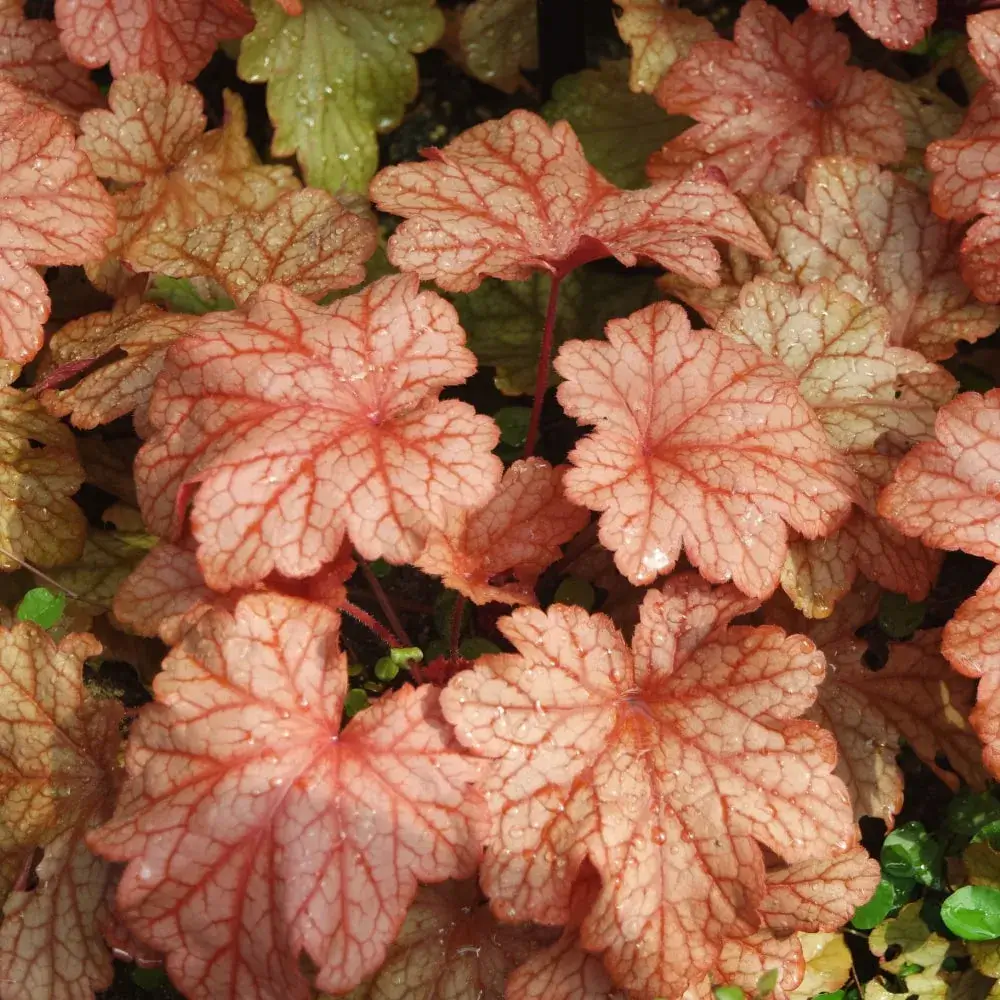Family: Coral Bells
Type: Perennial
Other Common Name: Coralbells, Alumroot

Georgia Peach Coral Bells are a stunning addition to any garden. Their large, peach-colored leaves with a silvery overlay create a luminous effect.
This perennial is renowned for its large, vibrant foliage and easy care. It’s a garden favorite for its year-round interest and adaptability.
Georgia Peach Coral Bells flourish in partial to full shade, making them perfect for brightening up darker areas. They are hardy in zones 4-9, proving resilient in various climates.
Hardiness Zone: 4a-4a
Pet Friendly: Yes
Moisture Preference: Average to moist
Sun Needs: Full sun to shade
Growth Rate: Medium
Average Height (feet): 1.5
Average Spread (feet): 1.5
Average Life Span (years): 10
Form: Over mound
Flower Color: Yellow
Flower Shape: Bell
Bloom Season: From mid summer to early fall
Foliage Color: Orange
Foliage Shape: Lobed
Incorporating Georgia Peach Coral Bells adds a warm, inviting tone to your garden. Their peachy hue is both unique and eye-catching.
Pair them with dark greens or purples for a stunning contrast. They work well in borders, woodland gardens, and as underplantings.
These plants are known for their drought tolerance once established. They adapt well to various soil conditions, making them a versatile landscaping choice.

In tropical gardens, Georgia Peach Coral Bells add a burst of color. Their lush foliage complements tropical plants, offering a contrasting texture and color.
In formal garden settings, these plants bring a soft, yet structured elegance. Their symmetrical leaf patterns are ideal for creating a refined, balanced look.
In rock gardens, the peach-colored leaves of these plants provide a beautiful contrast against the rocks and gravel. They thrive in the well-drained conditions typical of rock gardens.
Plant them in shaded patio areas for a splash of color. Their unique hue brightens up these often overlooked spaces.
Use them as ground cover in woodland gardens. They spread moderately, creating a cohesive, colorful undergrowth.
Mix them with spring bulbs for a multi-seasonal display. Their foliage complements the vibrant colors of spring flowers.
Select our pre-made garden layouts to create a landscape that’s uniquely yours. Simple, smart, and customizable!
In spring, the new leaves of Georgia Peach Coral Bells are bright and fresh. They add a soft, peachy glow to the garden, complementing spring blooms.
During summer, their foliage deepens in color, providing a steady backdrop of warm tones. They stand up well to the heat, maintaining their vibrant color.
In the fall, Georgia Peach Coral Bells' leaves may develop richer tones. They blend seamlessly with the changing colors of the season, adding depth to the autumn palette.
In winter, their leaves often remain, providing some winter interest. The peach tones stand out in the stark winter landscape, offering a hint of warmth.
Polystichum munitum
Hosta 'Patriot'
Pulmonaria
Georgia Peach Coral Bells excel in shaded to partially shaded areas. They are ideal for under tree canopies or in spots that receive morning sun and afternoon shade.
These plants prefer partial to full shade. They tolerate morning sun but should be protected from harsh afternoon rays, which can scorch their delicate leaves.
Georgia Peach Coral Bells thrive in well-draining soil. They prefer a slightly acidic to neutral pH and benefit from organic matter incorporated into the soil.
Space Georgia Peach Coral Bells about 15 to 20 inches apart. This spacing ensures adequate air flow, reducing the risk of fungal diseases and allowing for full growth.
The optimal planting times are spring or early fall. These cooler periods allow the plants to establish roots without the stress of extreme heat or cold.
Dig a hole as deep and twice as wide as the root ball. Set the plant in, ensuring the crown is level with the soil surface, and fill with soil. Water thoroughly after planting.
Georgia Peach Coral Bells require consistent moisture, especially in their first growing season. Once established, they are moderately drought-tolerant but still prefer regular watering.
A balanced, slow-release fertilizer applied in early spring promotes healthy growth. Avoid over-fertilizing, which can lead to weak growth and fewer leaves.
Prune back spent flower stalks and remove any damaged leaves. This keeps the plants looking neat and encourages more robust growth.
Remove any winter debris and apply mulch to conserve moisture. This is also the time to fertilize and begin regular watering as new growth appears.
Continue regular watering, especially in dry spells. Monitor for any signs of stress due to heat, and provide extra water if needed.
Reduce watering as the plant prepares for dormancy. Apply a layer of mulch to protect the roots from freezing temperatures in winter.
Winter care is minimal. Ensure the plants are well-mulched, and avoid overwatering as the plants are dormant.
Heuchera 'Forever Red'
Heuchera 'Georgia Peach'
Heuchera Primo 'Wild Rose'
Georgia Peach Coral Bells can reach up to 12-18 inches in height and 18-24 inches in width when mature, forming a sizeable mound of foliage.
Yes, Georgia Peach Coral Bells are generally deer resistant. Their foliage isn’t a preferred choice for deer, making them a good option for deer-prone areas.
Yes, these plants can be divided every 3-4 years. Dividing them in early spring or fall helps rejuvenate older plants and provides new plants for other areas of your garden.
Sign up below to get exclusive deals, discounts, and new plant collections—delivered straight to your inbox! Plus, stay inspired with the latest gardening tips, landscaping trends, and DIY garden ideas. Start growing with us today!
A big thank you for subscribing to the PBN Design newsletter.
We're thrilled to have you join our community. Get ready for exciting updates, insightful content, and more delivered straight to your inbox.
Stay tuned!
Go backA big thank you for subscribing to the PBN Design newsletter.
We're thrilled to have you join our community. Get ready for exciting updates, insightful content, and more delivered straight to your inbox.
Stay tuned!
Go back